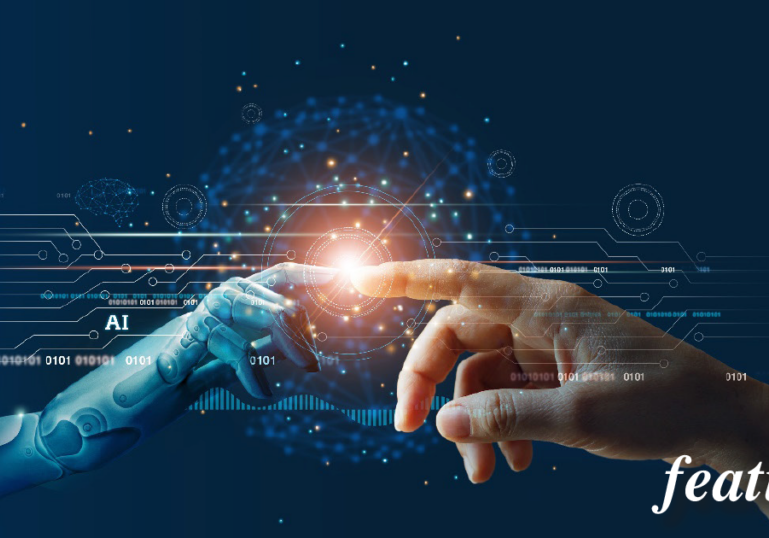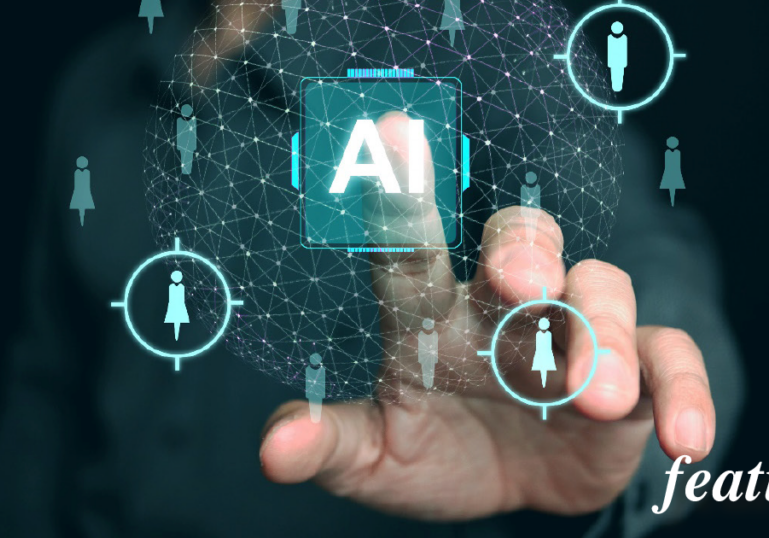In nearly every business conference, podcast, or webinar, AI is lauded as the “next” innovation or invention—for all functions and geographies. The same applies to HR, which constantly publishes and promotes how AI will change HR. We (and many others) have shared many innovations and experiments.
Mastering AI for HR requires a deep dive (not a keynote or high-level call to action) into AI and its implications for HR. To address both these overall AI and AI for HR issues, we held a two-day think tank with 55 senior HR leaders from 28 organizations.
Professor Nigel Melville, a nationally recognized expert on AI value and risk, brilliantly taught us to master the deep dive into AI. He talked about the principles of AI in general (not specifically related to HR).
- What is AI, and how does it work? Answer: AI represents a general-purpose technology that can better manage information by understanding, summarizing, analyzing, synthesizing, and generating texts, videos, sounds, and images. AI “emulates” human capabilities of cognition and communication, resulting in “a new kind of digital species” (quote by Mustafa Suleyman, CEO Microsoft AI).
- Why adopt it, and who is using it? Answer: Modern AI is getting better faster than any legacy AI by equaling human performance across a widening spectrum of tasks. And “every job is going to be changed by AI, some more than others” (Dan Shapiro, COO LinkedIn).
- How is AI being used? Answer: AI has opportunities and risks. Opportunities include intern (ChatGPT, Gemini) to process data and perform basic tasks; platform copilot (Salesforce Einstein) to boost productivity within a single app; domain guru that knows specific information about a corporate function; functional expert to perform specific tasks in particular ways such as a math tutor; and corporate guru for building unique AI applications for your company and for customer-facing services. Risks span poor or inappropriate response bias and reliability, requiring appropriate governance to align AI with the organization.
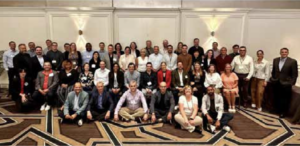 RBL Institute Think Tank on AI for HR Participants
RBL Institute Think Tank on AI for HR Participants
Drawing on this deep dive into AI and our RBL insights (ideas, research, solutions) on sustainable change and the next agenda for HR value creation, 55 senior HR leaders from 28 leading companies worked to identify areas where an organization can apply AI insights to HR. Using a nominal group technique, we engaged these 55 leaders to identify ten key actions to make AI for HR happen. In a world where AI for HR has become de rigueur, these ten dimensions can help any HR leaders assess how they are doing at applying AI for HR to their organization.
- Articulate a Business Case
AI is not about technology per se but about using technology to help a business be more effective. The business case often starts with how investments in AI will help the business be more efficient, productive, and cost-effective by more easily accessing information. When presenting AI for HR, the business rationale for doing so needs to be explicit. What is the return on investment for AI work?
- Add Value to All Stakeholders
We have expanded on the business case from “return on investment” to this logic that AI for HR should help each stakeholder (who are “human” or “people”) receive the value that matters to them from the information AI for HR provides. A stakeholder value logic ensures that each stakeholder understands and can use AI for HR in ways that help them. For example, when employees recognize how AI will help them do their jobs better, they will be more favorable towards it.
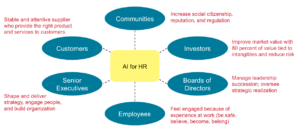 Figure 1. Stakeholder Value from AI for HR
Figure 1. Stakeholder Value from AI for HR
-
-
- Assign Accountability (Individual and/or Team)
-
Like any innovative initiative, AI for HR requires accountability. Senior business and HR executives may sponsor the work when they see the business and stakeholder value, but specific accountability helps move the work forward. This accountability may be to an HR professional with technical and analytics skills, but it is more often team accountability with individuals from HR, IT, operations, finance, and marketing. This individual or team champions AI for HR by defining goals, overseeing investments, managing processes, and reporting progress.
-
-
- Develop Talent Who Can Do AI
-
AI for HR requires that HR professionals have access to skills to get the work done. This may come from collaborating with IT experts, continuous education of the HR staff involved in AI for HR, and/or partnering with external experts. To remove employee fear, employees must realize that AI will not take their job—those who know how to use it will. So, all employees will benefit from being taught how to use AI to improve their work experience.
-
-
- Create Responsible/Harmless Policies
-
We acknowledge the well-stated risks of AI: data from open-source users may be wrong or damaging, proprietary data may be shared, machines working with other machines may be challenging to regulate, economic inequality, dependence on AI that replaces human creativity, and deep fakes. Responsible AI policies ensure that information sourced through AI is as accurate as possible and used to improve decision-making. As policymakers, HR professionals should craft AI for HR policies that “do no harm.”
-
-
- Use Simple Language
-
AI democratizes information through broad technologies, including natural language processing, speech recognition, machine learning, and genAI. Creating a simple but common language to decode this ever-changing and evolving technology becomes critical. Glossaries for many terms are available, and each organization may have its own unique definition of key concepts (see Figure 2 for key terms and generic definitions).
Figure 2. Generic Definitions of Key AI Concepts
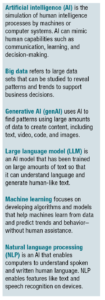
-
- Upgrade Business Processes Through AI
Every business has multiple processes, such as customer support, product development, sales, account management, budgeting, etc. As these processes become automated with statistical modeling, AI (using machine learning and genAI) can upgrade them by providing more information that improves each process.
-
-
- Create Metrics to Guide and Measure Success
-
Metrics track progress and ensure improvements. AI for HR requires metrics that track not only what is done (activities) but also the impact of those genAI activities on business results (see criteria 1) and stakeholders (see criteria 2). Since HR has a unique stewardship for employees, metrics should also track how employees use and respond to AI.
-
-
- Start with Low-Hanging Fruit
-
Getting started in AI for HR often begins with initiatives that can be done quickly and easily. We (and others) have discussed an S-curve or evolution of AI for HR. Those in our think tank and others suggest that AI for HR is 20 to 30 percent up the S-curve with a stronger focus on what we call “assist,” which is about streamlining, efficiency, and productivity gains, with an increasing amount of work on “inform” that focuses on sharing information (see figures 3 and 4). As AI for HR advances, we envision more “guidance” for identifying specific priorities. Eventually, we want to move to “stakeholder value,” where the impact of AI for HR creates value for all stakeholders.
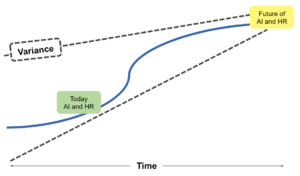
Figure 3. AI and HR S-Curve
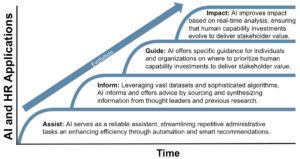
Figure 4. Stages to Make Progress
-
-
- Embrace the Human/Technology Interface
-
AI for HR complements human capacity. AI accesses, informs, and guides information that improves human decision-making capacity. Human creativity defines the AI algorithms, interprets the generated data, and anticipates how the information will be used. People and technology interface turn artificial intelligence into informed intelligence or wisdom.
Conclusion and Implication
These ten dimensions (see Figure 5) can become criteria for assessing your organization’s progress in using AI for HR. Number 11 in the figure includes what any specific organization might add for its individual setting. There was a meaningful range and distribution when the 28 companies tested themselves using these ten criteria.
We hope this assessment can advance AI for HR and offer specific insights on what can be improved.
How do you score? What are your high and low dimensions?
Figure 5. Criteria to Evaluate How Well Your Organization is Using AI for HR.

References
- Functions and geographies, https://bit.ly/3YqIfik
- Experiments, https://bit.ly/4d3Z6Mk
- Professor Nigel Melville, https://bit.ly/3LNOncU
- Mustafa Suleyman, CEO, Microsoft, https://bit.ly/46w8Nkk
- Dan Shapiro, COO, LinkedIn, https://bit.ly/4dpSCqY
- RBL Insights, https://bit.ly/4c2H4J7
- Sustainable Change, https://bit.ly/3A8X6DV
- Next agenda for HR value creation, https://bit.ly/3LP1ydq
- Each stakeholder, https://bit.ly/3LP1ydq
- Risks of AI, https://bit.ly/4djIRuR
- Responsible AI, https://bit.ly/3zYAt4T
- S-curve or evolution of AI, https://bit.ly/4c2INOB
(References in Figure 2. Generic Definitions of Key AI Concepts)
- Artificial Intelligence (AI), https://bit.ly/3WJTbpO
- Big Data, https://bit.ly/4ftAwpw
- Generative AI (genAI), https://bit.ly/4frgGeI
- Large language model (LLM), https://bit.ly/3A4UWFv
- Machine learning, https://bit.ly/4d10IGw
- Natural language processing (NLP), https://bit.ly/3WraUB6

